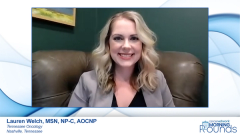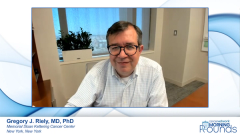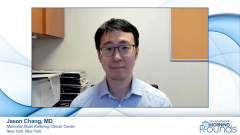
NSCLC: Treatment Options for Patients With Driver Mutations and PD-L1 Expression
Closing out their review of the second patient scenario, panelists define treatment options for NSCLC with both EGFR mutation and PD-L1 expression.
Episodes in this series

Transcript:
Gregory J. Riely, MD, PhD: Thinking about this patient, let’s say she doesn’t have a driver mutation when the NGS [next-generation sequencing] results come back. Lauren, do you want to take a stab at what you might treat this person with? She’s a driver negative, with a PD-L1 of 55%? How would you be thinking about this?
Jason Chang, MD: To clarify, is it negative for driver alterations on liquid NGS, or is it tissue-based NGS?
Gregory J. Riely, MD, PhD: Let’s say this is a driver negative on plasma NGS.
Jason Chang, MD: Then I’d definitely recommend doing NGS testing on tissue again to make sure we’re not missing anything.
Gregory J. Riely, MD, PhD: That’s important, and how we define negative on plasma is important as well. If you found a KRAS mutation, we wouldn’t call that negative. We’d just say that’s not a targetable oncogenic driver in this situation. But if we just found no mutations, we’d call that negative. We’d need to get the tissue to do more NGS.
Jason Chang, MD: Right.
Gregory J. Riely, MD, PhD: Great clarification. Back to you Lauren. PD-L1 is 55%, with no driver oncogene. We’re going to say that this is no-driver oncogene on tissue NGS as well.
Lauren Welch, MSN, NP-C, AOCNP: If that’s the case, then we’re probably going to suggest chemotherapy–I/O [immuno-oncology]. There are a couple of ways you can go about that. We’re still commonly using platinum-pemetrexed-pembrolizumab, but there are other choices too. You could have a conversation about PD-1 inhibitor alone. It wouldn’t feel great, given all the things we’ve talked about that make this patient unique. I’d still wonder if we’re missing something. Technically, you could give PD-1 monotherapy. But we’re doing more chemotherapy–I/O in these cases.
Gregory J. Riely, MD, PhD: That’s a challenging situation. That symptom burden often plays into decision-making. If you have a patient who’s minimally symptomatic, and you want to try to use single-agent I/O, then you can think about it. More often, we’re going to give a combination of checkpoint inhibitor plus chemotherapy.
Let’s rewind and pretend there was a different situation here, that this NGS result shows us that the patient has an EGFR mutation—let’s say an exon 19 deletion—and PD-L1 at 55%. Which do you pick, Lauren?
Lauren Welch, MSN, NP-C, AOCNP: That’s an easier question. We’re going to do first-line osimertinib in that situation. We don’t entirely understand that several patients have exon 19 deletion, EGFR mutations, or L858R with high PD-L1 expression. But it doesn’t seem to mean the same thing in these patients. They’re often never-smokers. They don’t respond the same way to checkpoint inhibitors, and osimertinib is excellent first line—tolerable with great efficacy and responses—so we’d definitely do osimertinib first line for that patient.
Gregory J. Riely, MD, PhD: That makes a lot of sense. There was a very small study that changed a lot of people’s minds a few years back. It was done in California. They took patients who had PD-L1–positive tumors and EGFR mutations and gave them single-agent pembrolizumab. Of 10 patients, none responded to pembrolizumab. It was pretty clear that the oncogenic driver of EGFR is a clear indication that you should move forward with the drugs that are targeting EGFR.
Transcript edited for clarity.
Newsletter
Stay up to date on recent advances in the multidisciplinary approach to cancer.





















































































